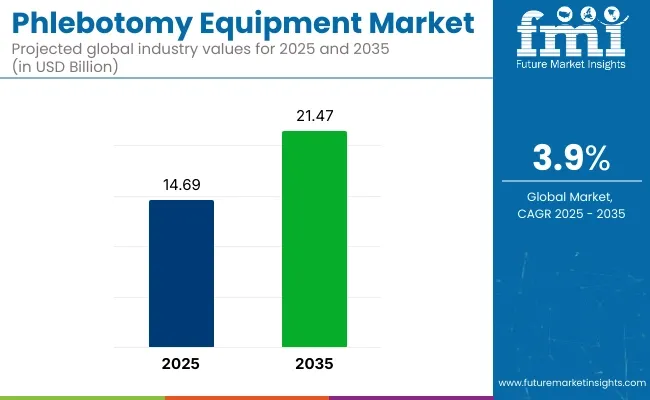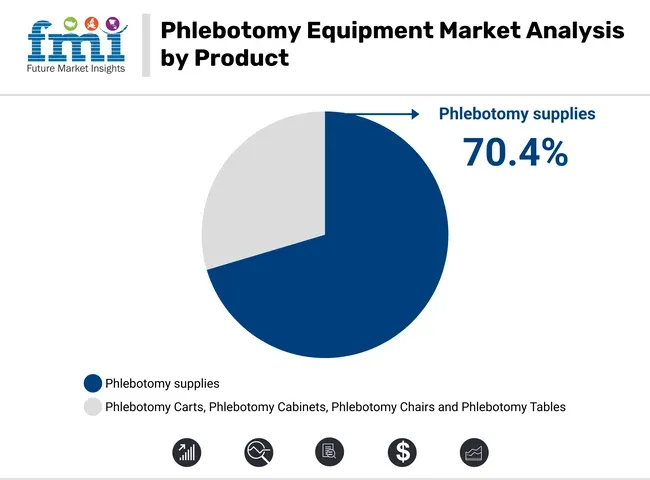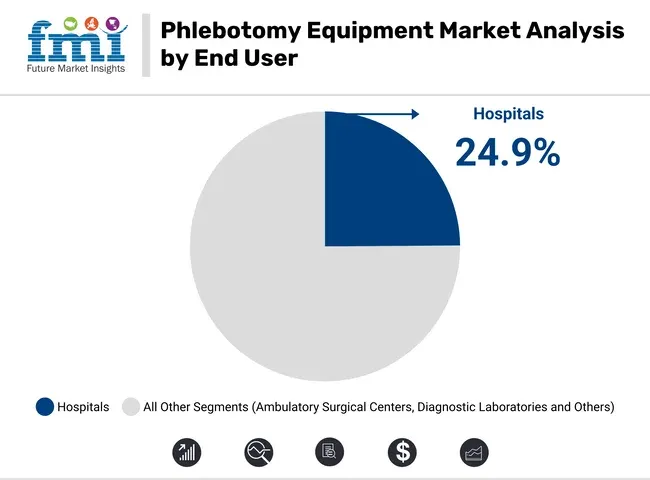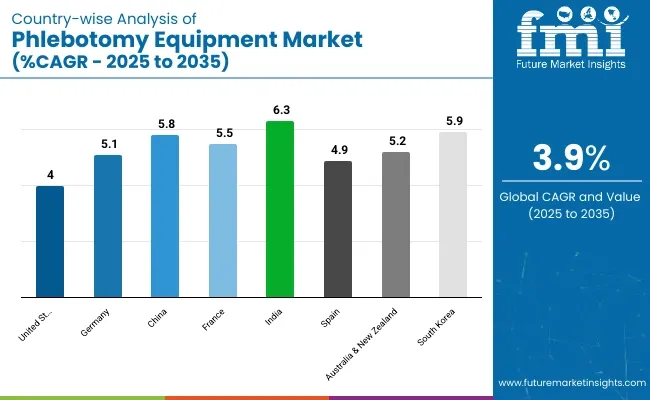Sales of phlebotomy equipment are likely to be at USD 14.69 billion in 2025. By 2035, the market is projected to reach USD 21.47 billion at a CAGR 3.9% during the forecast period.
This growth is being driven by the increasing demand for blood collection equipment in healthcare facilities, as well as the rising global prevalence of chronic diseases, which require regular blood testing and monitoring. Phlebotomy equipment is crucial for safely and effectively collecting blood samples for diagnostic purposes, supporting medical professionals in their efforts to deliver timely and accurate healthcare.
The growing demand for diagnostic testing, particularly in response to the ongoing global health concerns, has significantly boosted the market for phlebotomy equipment. Additionally, the rise of preventive healthcare and wellness initiatives has led to an increased need for routine health checkups and screenings, further driving the demand for blood collection tools. Hospitals, diagnostic laboratories, and outpatient care centers continue to be the primary consumers of phlebotomy equipment, which includes items such as blood collection tubes, needles, syringes, and lancets.

| Attribute | Value |
|---|---|
| Market Size in 2025 | USD 14.69 billion |
| Market Size in 2035 | USD 21.47 billion |
| CAGR (2025 to 2035) | 3.9% |
Technological advancements in phlebotomy equipment have also contributed to the market’s growth. The development of safer, more efficient, and less invasive equipment has improved the patient experience and minimized the risk of infection or injury during the blood collection process.
Innovations such as self-contained, safety-engineered devices that reduce the risk of needlestick injuries have been widely adopted in healthcare settings. These advancements not only improve safety but also enhance the efficiency and comfort of the blood collection process.
On December 17, 2024, BD (Becton, Dickinson and Company) and Babson Diagnostics announced the expansion of their fingertip blood collection and testing technologies for use in U.S. health systems and other large provider networks in settings like urgent care centers, doctor's offices, and other ambulatory care settings.
This innovative blood testing process integrates BD's MiniDraw™ Capillary Blood Collection System with Babson's BetterWay technologies to enable test results from as few as six drops of capillary blood collected from a patient's finger. With this less-invasive alternative to venipuncture blood draws, samples can be collected and prepared by any trained healthcare worker—including those without prior phlebotomy experience. This was officially announced in the press release of the company.
As the healthcare sector continues to evolve, the demand for efficient, safe, and reliable phlebotomy equipment will remain strong, propelling the market forward and creating opportunities for innovation in the years ahead.
The below table presents the expected CAGR for the global phlebotomy Equipment market over several semi-annual periods spanning from 2025 to 2035. In the first half (H1) of the decade from 2024 to 2035, the business is predicted to surge at a CAGR of 4.6%, followed by a slightly lower growth rate of 4.3% in the second half (H2) of the same decade.
| Particular | Value CAGR |
|---|---|
| H1 (2024 to 2034) | 4.6% |
| H2 (2024 to 2034) | 4.3% |
| H1 (2025 to 2035) | 3.9% |
| H2 (2025 to 2035) | 3.4% |
Moving into the subsequent period, from H1 2025 to H2 2035, the CAGR is projected to decrease slightly to 3.9% in the first half and decrease moderately at 3.4% in the second half. In the first half (H1) the market witnessed a decrease of 70.00 BPS while in the second half (H2), the market witnessed an increase of 90.00 BPS.
The global phlebotomy equipment market is projected to grow significantly from 2025 to 2035. Key segments driving this growth include phlebotomy supplies and hospitals. These segments are fueled by increasing healthcare needs, advancements in medical technology, and the growing demand for efficient blood collection processes.
Phlebotomy supplies are expected to account for 70.4% of the market share in 2025. This segment dominates due to the essential role of phlebotomy supplies in blood collection procedures across healthcare facilities.
Products such as needles, collection tubes, lancets, and blood bags are critical for ensuring the efficiency and safety of blood collection, which is central to diagnostics, treatment monitoring, and medical procedures. The increasing number of diagnostic tests, outpatient procedures, and routine medical checkups is driving the growing demand for these supplies.

Key players like Becton Dickinson and Terumo Corporation are leading innovations in this segment by developing advanced phlebotomy products that reduce patient discomfort, improve safety, and minimize the risk of contamination.
Additionally, there is a growing focus on eco-friendly phlebotomy supplies, with companies creating recyclable or biodegradable collection materials to meet sustainability goals. As the global healthcare system expands, particularly in emerging markets, the demand for phlebotomy supplies is expected to remain strong.
Hospitals are projected to hold 24.9% of the phlebotomy equipment market share by 2025. This segment’s growth is driven by the increasing number of hospital admissions, routine diagnostic procedures, and surgical interventions that require blood collection and analysis.
Hospitals are the primary healthcare facilities performing phlebotomy procedures, particularly for inpatient care, diagnostic testing, and emergency situations. The growing prevalence of chronic diseases, such as diabetes, cardiovascular conditions, and infectious diseases, is further contributing to the demand for phlebotomy equipment.

Leading companies are providing hospitals with automated blood collection devices and integrated solutions that improve the accuracy, safety, and speed of phlebotomy procedures. Additionally, with the rise of point-of-care testing and the adoption of minimally invasive techniques, hospitals are increasingly adopting advanced phlebotomy equipment that enhances patient outcomes and reduces procedural risks. As hospitals continue to invest in modernizing their diagnostic and treatment capabilities, the demand for phlebotomy equipment in this segment is expected to grow significantly in the coming years.
Increasing Applications for Collection, Testing and Blood Storage Is Increasing Adoption of Phlebotomy Equipment.
Phlebotomy equipment is important in acquiring samples for diagnostic testing. This diagnostic testing is for diagnosing a variety of medical conditions, such as infections, blood disorders, and chronic diseases. With an increase in these conditions, there is an increase in the demand for diagnostic testing.
According to America's Blood Centers statistics 2022, blood centers in the United States provided 10,879,000 RBCs to hospitals in 2019. United States. blood centers also provided 2,508,000 units of platelets (both apheresis and whole blood derived) to hospitals in 2019. Blood centers in the United States. provided hospitals with 2,679,000 units of plasma in 2019. These statistics indicate the extensive use of phlebotomy equipment.
Blood storage is an important process in the blood banking industry, where phlebotomy equipment is used, because it helps in maintaining the quality of blood and its medical effectiveness. Blood products' storage in a blood bank is crucial for the blood banks since it enables them to establish a stable supply of safe blood that can be stored for long periods without losing effectiveness.
Health care service providers need phlebotomy equipment to get blood samples with a high level of safety and effectiveness, thereby assuring diagnosis, proper treatment, and good research output. Blood collection equipment plays a core role in the critical healthcare process that necessitates continuous demand and growth in the market.
Increasing Awareness about blood safety is favoring the Growth for Phlebotomy Equipment Market
Blood collection has faced growing concerns about healthcare-associated infections, bloodborne pathogens, and needlestick injuries, and the necessity to increase safety for the patient and the healthcare provider has gained importance. It becomes essential that phlebotomy equipment promote blood safety and incorporate safety-engineered needles and needleless blood collection systems.
It is a procedure for keeping safe and effective practices about the collection, storage, and usage of the donated blood. Collected together, they are termed as haemovigilance and encompass the entire chain of the transfusion process. It standardizes the use of blood in the healthcare sector.
The WHO Global Database on Blood Safety (GDBS) was established in 1998 with the objective to collect and analyze data from all countries on blood and blood product safety as the basis for effective action to improve blood safety and availability globally. The starting point of a safe blood supply is a stable population of regular voluntary non-remunerated blood donors.
According to World Health Organization - Global Status Report On Blood Safety and Availability (2021), It is estimated that 118.5 million blood donations were made in the 171 countries during the reporting period. 40% of these are collected in high-income countries, home to 16% of the world’s population.
Conclusion Rising awareness on blood safety is a must for the prevention of the infectious diseases being transmitted, maintaining patient and healthcare worker's safety, promotion of public health, maintenance of healthcare systems, and observance of legal and ethical standards in healthcare practice.
Increasing Demand for Diagnostic Testing a Significant Market Opportunity for Phlebotomy Equipment
The need for diagnostic testing is increasing with patient numbers at an all-time high and healthcare services at capacity. However, simple and safe solutions, along with digitized or consolidated services, will improve clinical scenarios and allow for quicker and more equitable access to health care.
Demand for diagnostic testing continues to rise due to converging factors. Non-communicable diseases are widespread; According to National Association of Chronic Disease Directors (2022), Nearly 60% of adult Americans have at least one chronic disease. Chronic conditions like diabetes, cancer, and cardiovascular disease are the leading causes of death in the United States.
Further increased preventive healthcare and early diagnosis to improve health outcomes by decreasing healthcare costs. Some programs include screening, well-health check-ups, as well as wellness initiatives urging patients to undergo routine diagnostics tests for early detection and recognition of health conditions, all with increasing demand for medical devices that are used in a screening and preventive healthcare framework.
Advanced and safety-enhanced phlebotomy equipment is becoming the need of the hour to improve patient outcomes and avoid diagnostic errors. Therefore, the rising demand in the market has opened new doors for innovation and portfolio expansion among the market players to meet the growing needs of diagnostic laboratories.
Lack of Skilled Professionals Is Emerging as Significant Growth Barrier for Phlebotomy Equipment Market.
This involves highly trained and skilled medical workers to operate. Since only a few individuals can properly operate the devices used for blood collection and sample handling, the usage of equipment in phlebotomy is limited due to shortages of skilled phlebotomists or healthcare workers who can employ the techniques in blood collection.
Medical errors, majorly caused due to unskilled workers, are the third-leading cause of death after heart disease and cancer. The USA Food and Drug Administration receives over 100,000 reports of medication errors each year. 41% of US citizens have claimed to be the sufferer of a medical error.
According to the United States. Bureau of Labor Statistics (BLS) 2021, employer demand for phlebotomists is projected to increase by 17% between 2019 and 2029
Overall, the absence of skilled professionals in phlebotomy presents a major restraint in the market for phlebotomy equipment because of its implications on training cost and time, quality, and accuracy concerns, and the possibility of adverse events. Addressing this skills gap will therefore be fundamental to the realization of phlebotomy equipment's potential in the health care sector.
Tier 1 companies comprise market leaders with a significant market share of 26.1% in global market. These companies engage in strategic partnerships and acquisitions to expand their product portfolios and access cutting-edge technologies.
Additionally, they emphasize extensive clinical trials to validate the efficacy and safety of their products. Prominent companies in tier 1 include Cardinal Health, Source-Ray, Inc., Becton, Dickinson and Company, Terumo Medical Corporation and Medline Industries, Inc.
Tier 2 companies include mid-size players with revenue of USD 50 to 100 million having presence in specific regions and highly influencing the local market and holds around 33.5% market share. They typically pursue partnerships with academic institutions and research organizations to leverage emerging technologies and expedite product development.
These companies often emphasize agility and adaptability, allowing them to quickly bring new treatments to market, additionally targeting specific types medical conditions. Additionally, they focus on cost-effective production methods to offer competitive pricing. Prominent companies in tier 2 include F.L. Medical, Timedico A/S, Heathrow Scientific LLC and JAC Medical Products Inc.
Finally, Tier 3 companies, such as LI Marketlab, Inc., UMF Medical, Hill Laboratories Company and Clinton Industries, Inc. They specialize in specific products and cater to niche markets, adding diversity to the industry.
Overall, while Tier 1 companies are the primary drivers of the market, Tier 2 and 3 companies also make significant contributions, ensuring the phlebotomy Equipment sales remains dynamic and competitive.
The section below covers the industry analysis for the phlebotomy Equipment market for different countries. Market demand analysis on key countries in several regions of the globe, including North America, Latin America, East Asia, South Asia & Pacific, Western Europe, Eastern Europe and Middle Ease & Africa, is provided.
The United States is anticipated to remain at the forefront in North America, with higher market share through 2035. In South Asia & Pacific, India is projected to witness a CAGR of 4.0% by 2035.

| Countries | Value CAGR (2025 to 2035) |
|---|---|
| United States | 4.0% |
| Germany | 5.1% |
| China | 5.8% |
| France | 5.5% |
| India | 6.3% |
| Spain | 4.9% |
| Australia & New Zealand | 5.2% |
| South Korea | 5.9% |
United States. phlebotomy Equipment market is poised to exhibit a CAGR of 4.0% between 2025 and 2035. Currently, it holds the highest share in the North American market.
The United States dominates the phlebotomy Equipment market because of its strong research and development ecosystem in life sciences, biotechnology, and pharmaceuticals. It has a huge number of academic institutions, research organizations, and private companies driving continuous innovation in molecular biology and protein analysis. Advanced phlebotomy Equipment techniques come as an example of these, where US-based researchers and biotech companies pioneer more efficient.
Collaborative R&D projects between medical device companies and academic institutions are accelerating the development of next-generation solutions, including minimally invasive and wearable blood sampling devices. Additionally, significant investments in material science research aim to produce eco-friendly and single-use products that meet regulatory and environmental standards.
This dedicated focus on R&D ensures the continuous evolution of phlebotomy technologies, addressing emerging healthcare needs and driving the availability of cutting-edge products in the United States market.
China’s phlebotomy Equipment market is poised to exhibit a CAGR of 5.8% between 2025 and 2035. Currently, it holds the highest share in the East Asia market, and the trend is expected to continue during the forecast period.
China has established itself as a global hub for medical device production, leveraging cost-effective manufacturing processes, advanced infrastructure, and skilled labor. These factors allow it to produce quality phlebotomy equipment at inexpensive rates for the local population while maintaining competitive prices for markets overseas.
Furthermore, its efforts on technological innovation coupled with government support for the healthcare industry have further enhanced the innovation of advanced blood collection devices. The Chinese manufacturers are increasingly placing a focus on automation and safety features along with product precision to meet global standards. The increasing healthcare infrastructure as well as the population in China add to the demand in the phlebotomy equipment market, which ensures it is at the top of this market.
India’s phlebotomy Equipment market is poised to exhibit a CAGR of 6.3% between 2025 and 2035. Currently, it holds the highest share in the South Asia & Pacific market, and the trend is expected to continue during the forecast period.
Lifestyle changes, aging demographics, and urbanization have increased the prevalence of diabetes, cardiovascular diseases, cancer, and kidney disorders. These diseases require regular blood tests for diagnosis, monitoring, and treatment, hence creating a consistent demand for advanced and reliable phlebotomy equipment.
The increasing demand is being addressed by the growing healthcare infrastructure in India through more diagnostic capabilities, especially in urban and semi-urban areas. The expanding network of hospitals, diagnostic labs, and blood banks is adopting modern blood collection devices to improve accuracy and patient comfort.
Moreover, increased health awareness and routine screening programs have further accelerated blood testing volumes, establishing chronic disease prevalence as a significant driver for market growth in India.
The market players are using strategies to stay competitive, such as product differentiation through innovative formulations, strategic partnerships with healthcare providers for distribution. Another key strategic focus of these companies is to actively look for strategic partners to bolster their product portfolios and expand their global market presence.
Recent Industry Developments in Phlebotomy Equipment Market
| Report Attributes | Details |
|---|---|
| Current Total Market Size (2025) | USD 76.7 billion |
| Projected Market Size (2035) | USD 121.5 billion |
| CAGR (2025 to 2035) | 4.7% |
| Base Year for Estimation | 2024 |
| Historical Period | 2020 to 2024 |
| Projections Period | 2025 to 2035 |
| Quantitative Units | USD billion for dollar sales |
| Materials Analyzed (Segment 1) | Plastic (PE, PP, PVC, PET, Other), Paper (Kraft, Recycled), Foil |
| Product Types Analyzed (Segment 2) | Pressure Sensitive Labels, Shrink Labels, Stretch Labels, Wet Glue Labels, Others (In-mold, Pre-gummed) |
| Printing Technologies Analyzed (Segment 3) | Flexographic Printing, Digital Printing, Gravure Printing, Offset Printing, Letterpress Printing |
| Ink Types Analyzed (Segment 4) | Solvent Based, Water Based, UV Based, Others (Latex Based) |
| End-uses Analyzed (Segment 5) | Food (Bakery & Confectionery, Dairy Products, Baby Food, Chilled or Frozen Foods, Others), Beverages (Alcoholic, Non-alcoholic), Pharmaceuticals (Tablets/Capsules, Cream & Ointment, Liquid Syrup, Others), Cosmetics & Personal Care, Homecare & Toiletries, Chemicals, Automobiles, Other Industrial |
| Regions Covered | North America, Latin America, East Asia, South Asia & Pacific, Western Europe, Eastern Europe, Middle East & Africa |
| Countries Covered | United States, Canada, Mexico, Brazil, Argentina, Germany, France, United Kingdom, Italy, Spain, Netherlands, China, India, Japan, South Korea, ANZ, GCC Countries, South Africa |
| Key Players influencing the Labels Market | Fuji Seal International, Inc., 3M Company, AVERY DENNISON CORPORATION, CCL Industries, UPM Global, Toray Plastics (America), Inc., Huhtamäki Oyj, Amcor plc, Klöckner Pentaplast, Allen Plastic Industries Co., Ltd. |
| Additional Attributes | dollar sales, CAGR trends, material type segmentation, product type demand, printing technology shifts, ink type usage, end-use industry trends, competitor dollar sales & market share, regional growth patterns |
In terms of product, the industry is divided into- Phlebotomy supplies, phlebotomy carts, phlebotomy cabinets and phlebotomy chairs and phlebotomy tables.
In terms of usage, the industry is segregated into- disposable devices and reusable devices.
In terms of end user, the industry is segregated into- Hospitals, ambulatory surgical centers, diagnostic laboratories, skilled nursing facilities, long term care centers, specialty clinics, blood banks and home healthcare providers and others.
Key countries of North America, Latin America, Western Europe, Eastern Europe, South Asia and Pacific, East Asia and Middle East and Africa (MEA) have been covered in the report.
The global phlebotomy Equipment market is projected to witness CAGR of 3.9% between 2025 and 2035.
The global phlebotomy Equipment industry stood at USD 14,044.3 million in 2024.
The global phlebotomy Equipment market is anticipated to reach USD 21.47 billion by 2035 end.
India is set to record the highest CAGR of 6.3% in the assessment period.
The key players operating in the global phlebotomy Equipment market include Cardinal Health, Source-Ray, Inc., Becton, Dickinson and Company, Terumo Medical Corporation, SARSTEDT AG & Co. KG, Medline Industries, Inc., Vitrex Medical A/S, F.L. Medical, Timedico A/S, Heathrow Scientific LLC and JAC Medical Products Inc.






Full Research Suite comprises of:
Market outlook & trends analysis
Interviews & case studies
Strategic recommendations
Vendor profiles & capabilities analysis
5-year forecasts
8 regions and 60+ country-level data splits
Market segment data splits
12 months of continuous data updates
DELIVERED AS:
PDF EXCEL ONLINE
U.S. Phlebotomy Equipment Market Analysis – Trends, Growth & Forecast 2024-2034
Equipment Management Software Market Size and Share Forecast Outlook 2025 to 2035
Equipment cases market Size and Share Forecast Outlook 2025 to 2035
Golf Equipment Market Size and Share Forecast Outlook 2025 to 2035
Port Equipment Market Size and Share Forecast Outlook 2025 to 2035
Farm Equipment Market – Advanced Agricultural Machinery 2024-2034
Pouch Equipment Market Growth – Demand, Trends & Outlook 2025 to 2035
Mining Equipment Industry Analysis in Latin America Size and Share Forecast Outlook 2025 to 2035
Subsea Equipment Market Size and Share Forecast Outlook 2025 to 2035
Pavers Equipment Market Size and Share Forecast Outlook 2025 to 2035
Tennis Equipment Market Analysis - Size, Share, and Forecast Outlook 2025 to 2035
Galley Equipment Market Analysis and Forecast by Fit, Application, and Region through 2035
Garage Equipment Market Growth – Trends & Forecast 2024-2034
Sorting Equipment Market Size and Share Forecast Outlook 2025 to 2035
General Equipment Rental Services Market Size and Share Forecast Outlook 2025 to 2035
Bagging Equipment Market Size and Share Forecast Outlook 2025 to 2035
RF Test Equipment Market Size and Share Forecast Outlook 2025 to 2035
Medical Equipment Covers Market Size and Share Forecast Outlook 2025 to 2035
Telecom Equipment Market Size and Share Forecast Outlook 2025 to 2035
Welding Equipment And Consumables Market Size and Share Forecast Outlook 2025 to 2035

Thank you!
You will receive an email from our Business Development Manager. Please be sure to check your SPAM/JUNK folder too.
Chat With
MaRIA